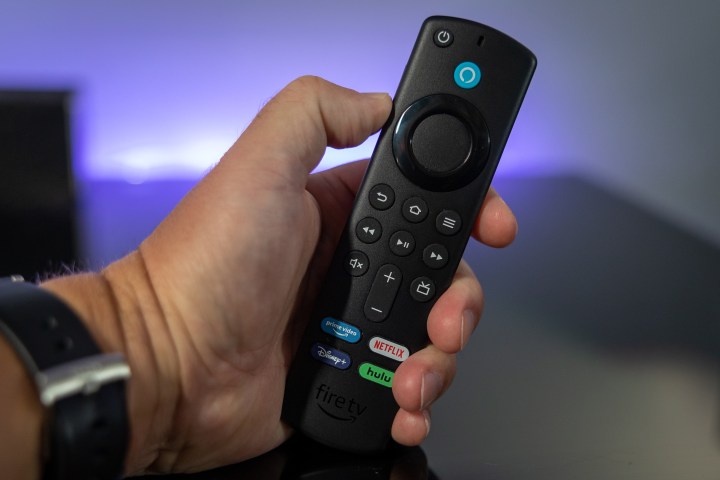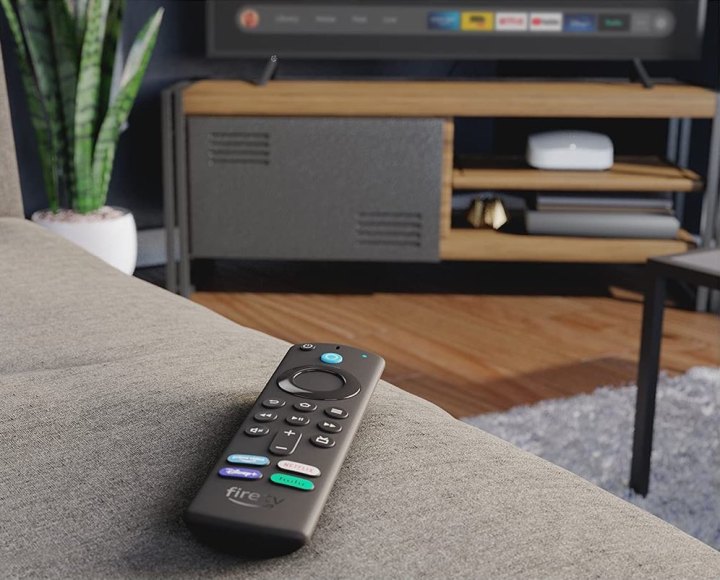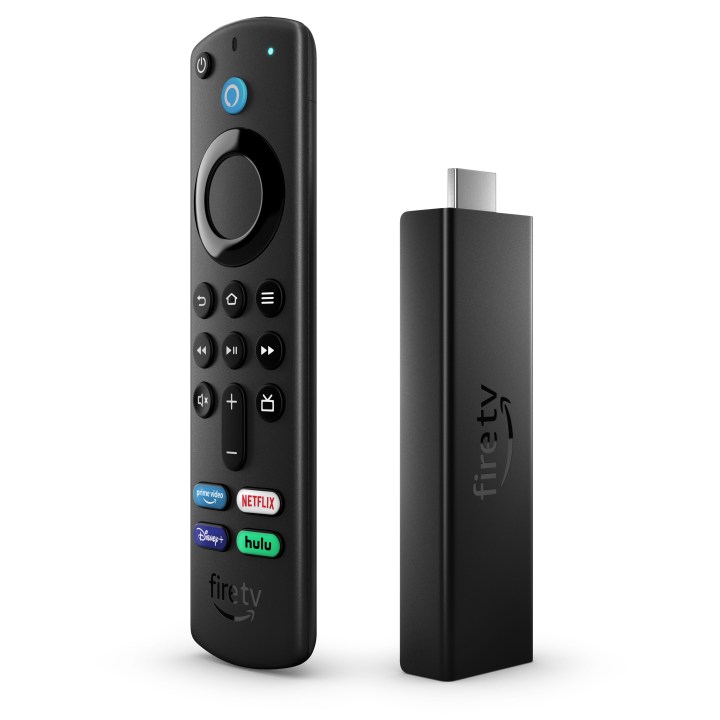If you’ve been looking for a fast, cheap, and user-friendly way to experience the growing world of streaming media, an Amazon Fire TV product is an excellent option for all your Netflix-adjacent needs. With most of Amazon’s hardware requiring nothing more than a Wi-Fi connection and a TV to plug into, you’ll be able to get connected to all that content in no time at all.
Some Fire TV devices even give you the ability to interact with Alexa, making voice control over your TV as easy as saying, “Alexa, open Netflix.” But there are several kinds of Fire TV devices, each with a different price, design, and features. Which Amazon Fire TV product is right for you? We’ll take an in-depth look at the five current Amazon Fire TV models — the Fire TV Stick Lite, Fire TV Stick, Fire TV Stick 4K, Fire TV Stick 4K Max, and the Fire TV Cube — so you can get a feel for what each one offers.
Fire TV Stick and Fire TV Stick Lite

The Amazon Fire TV Stick is identical to the Amazon Fire TV Stick Lite, with only a couple of exceptions. The Fire TV Stick includes TV controls on the remote and native support for Dolby Atmos. The cost of the Amazon Fire TV Stick is $40 for those extra features, while the Lite is just $30 (and frequently on sale for much less), making it not only the least expensive Fire TV device you can buy but also one of the least expensive media streamers, period. That said, the Fire TV Stick and its Lite version share all kinds of great features, and it’s up to you to decide which are most important to you.
Both devices share a blazing-fast interface, tons of great content, and a wide selection of apps and games. An optional Ethernet adapter is available, but their 802.11ac Wi-Fi connection should be plenty fast for most users, especially as the devices are limited to 1080p HD content. The latest 3rd-generation models include 1GB of memory, and in 2021, the Fire TV and Fire TV Lite remotes were upgraded with the newer 3rd-gen Alexa Voice Remote and Voice Remote Lite, respectively. Both remotes have a dedicated button for summoning Alexa, but the main difference is that the Fire TV version has buttons for volume control and power.
Each Fire Stick has 8GB of onboard storage for downloaded apps and games, which is more than any other stick-based streamer. While you won’t get 4K streaming on either (see below for the 4K version, if that’s your jam), you do get access to a massive library of Fire TV apps, which includes virtually all of the most popular subscription services like Disney+, HBO, ESPN, and CBS All Access, plus a ton of free options too, like YouTube, PlutoTV, Tubi, and more. If you’re an Apple fan, you can even get the Apple TV app, which is needed for accessing Apple TV+.
There are also two major browser apps: Amazon’s own Silk web browser and a version of Firefox. This is a rarity in the streaming media device world, where you won’t find easy browser options on Apple TV, Roku, or even Google TV.
The Fire TV Stick and Stick Lite can also run games — a surprising number of them given these devices are not really targeted toward gamers — but you’ll have to buy a compatible game controller to get the most out of them. Many Bluetooth controllers, like the Sony DualShock 4, will work, but beware: Amazon’s own Fire TV game controller, mysteriously, does not. The Fire TV remote will also work for many of these games.
The latest versions of the Fire TV Stick and TV Stick Lite now support HDR, HDR10, HDR10+, and HLG picture formats, which is a step up toward a much better viewing experience as these formats become much more widely used across streaming platforms. And while the Lite is still limited to just HDMI audio passthrough for Dolby-encoded audio (which is just fine in most cases), the Fire Stick has native support for Dolby Atmos so you can enjoy its amazing object-based surround format.
Our reviews of the Amazon Fire TV Stick and Fire TV Stick Lite
Amazon Fire TV Stick 4K

Those high-end audio and video options that are missing from the Fire TV Stick are the whole reason Amazon created the Fire TV Stick 4K. The Fire TV Stick 4K does everything we described above, but if you own a 4K TV — especially if it is an HDR-capable model — that $10 buys you a lot of additional joy. This model also is slightly faster, with 1.5GB of memory. The Amazon Fire TV Stick 4K costs $50.
We probably don’t need to tell you that 4K HDR content looks absolutely stunning, making all older movies and shows look dull and lifeless by comparison. And since streaming services like Amazon Prime Video and Netflix are quickly embracing 4K HDR, you owe it to yourself to get the Fire TV Stick 4K.
We’d also like to point out that the Fire TV Stick 4K is the only streaming media player we’ve found that supports every single flavor of HDR, including HDR10, HLG, HDR10+, and Dolby Vision. That’s nothing short of amazing given that devices that can cost up to four times the price of the Fire TV Stick 4K don’t offer this level of future-proofing.
Dolby Atmos support is also part of the package. Not all surround sound is created equal, and if you have a sound system that is Dolby Atmos capable, you need a media streamer that supports Dolby Atmos to take advantage of it. With an increasing amount of Atmos content showing up on Netflix and Prime Video, it’s the right time to own a device that can handle it.
Our full Fire TV Stick 4K review
Amazon Fire TV Stick 4K Max

The Amazon Fire TV Stick 4K Max is the newest version of the Amazon Fire TV stick to be released. It includes all the features listed above in that Amazon Fire TV Stick 4K model as well as being 40% more powerful, which allows your apps to start faster and have more fluid navigation. It includes slightly more memory than the original 4K version with 2GB of memory included, which is the same as the Amazon Fire TV Cube. The cost of the Amazon Fire TV Stick 4K Max Pro is $55.
If your home network includes Wi-Fi 6, then this is the only Amazon Fire TV product that supports that. It also includes Live View Picture-in-Picture, which allows you to view your front door camera, for example, without stopping your show.
Amazon Fire TV Cube
You’ll notice one thing right off the bat with the Fire TV Cube: It’s not nearly as budget-friendly as its Fire TV Stick brethren. But if you’re looking for the most powerful and feature-rich Amazon streaming peripheral you can get your hands on, the Fire TV Cube is the way to go.
The newest version of the Cube ditches the all-gloss exterior of the previous generation in favor of a mesh-covered chassis, which allows the newest Cube to look more like an Amazon smart speaker than ever before. And guess what? It actually is an Alexa-powered smart speaker. Not only will you be able to use the Cube to stream all your favorite Fire TV apps and games, but onboard Alexa will allow you to go completely remote-less, featuring voice-activated controls for volume adjustment, channel searching (more on that in a moment), and the ability to interact with your home’s range of compatible smart home devices.
There are also a few new input/output elements for the 2022 Cube, including an Ethernet port, a USB-A connection (instead of the previous version’s Micro USB), and an HDMI-in port, which allows you to connect and control certain AV equipment using Alexa. While some households may use the included Ethernet port to connect directly to a router, the latest Cube is also built from the ground up to handle the latest Wi-Fi 6E protocol, and with its octa-core processor, this makes the all-new Fire TV Cube one of the fastest-performing streaming devices on the market.
It’s not the cheapest Fire TV product you can get your hands on (the new Cube currently sells for $140), but if you’re looking for a blistering-fast streaming experience, complete with support for all the leading HDR picture formats of today, along with Dolby Atmos audio, the Fire TV Cube is the way to go.
Read our full Fire TV Cube (2022) review
Which Amazon Fire TV Stick should you get?
If you are looking for the cheapest option to enter the Amazon Fire TV stick market, then the Fire TV Stick Lite is your choice at $30. Keep in mind, though, that it’s missing several features that may be important to your TV watching.
We think that for the $25 premium over the price of the Fire TV Stick Lite, anyone with a 4K TV — or anyone who thinks they may buy a 4K TV in the next few years — should buy the Fire TV Stick 4K Max. This is the newest Fire TV Stick model and is better and faster than all the previous Fire TV Stick versions. Its combination of apps, games, and streaming services both paid and free, plus an unequaled level of support for all of today’s top audio and video formats, make it a stellar value. When you add Alexa’s ability to give you voice control over your content as well as your smart home, plus Wi-Fi 6 support, it’s hard to conceive of a reason Fire TV shoppers shouldn’t buy it.
We love the Fire TV Cube, but we also acknowledge it isn’t for everyone. It’s expensive (relatively speaking) and doesn’t handle travel as well as the Sticks. But if you secretly harbor a desire to turn your home theater into your very own USS Enterprise bridge, complete with a computer that responds to voice commands, the Fire TV Cube is your passport to the captain’s chair.
Editors' Recommendations
- Best Samsung TV deals: Save on 4K TVs, QLED TVs, OLED TVs, 8K TVs
- Let’s discuss an Apple TV 4K with a camera
- Best 65-inch TV deals: Get a 65-inch 4K TV for under $400
- Best Apple TV deals: Save on the Apple TV 4K and more
- The best 4K TVs under $500: premium picture on a budget







